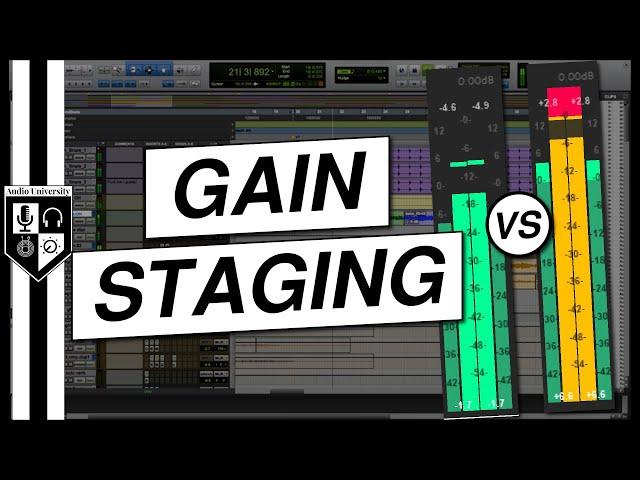
Gain Staging Secrets Every Great Audio Engineer Understands!
Комментарии:

Love your videos sooooo much. So much to learn! Thank you ❤❤❤
Ответить
just learned two things I've never known across 20+ years of producing and mixing! thank you sir! so happy I happened across this channel!!! this is APPLY called "Audio University"
Ответить
When I am recording a rap song, should my take average -18db and peak at -12db?
Ответить
Priceless
Ответить
Dope video - thanks brother!
Ответить
Thanks for the video✌🏻
Ответить
If mr. Burns from the simpsons did a origin story…
Ответить
Really liking this guy ,its like no nonsense, easy to understand, he has been teaching this old guy a few things
Ответить
Well explained but, I hope I’m not being too critical, but I hear excess background noise in this video.
Ответить
How about DJing? I've heard some people have -8 LUFS on the songs, some -14. Could you explain how to setup songs on the optimal LUFS for DJing please? Thank you for your videos! They all are very useful!
Ответить
Thankyou, you change my career. Be better.
Ответить
Why not just pull the master fader down in the DAW? I use reaper and so do you. I don't know about other DAWs but reaper uses 64bit floating point for internal processing. I don't imagine anyone is going to clip that.
So why not just pull the master fader down and start setting your level balance between tracks, when it is approximately correct then you can select all tracks and apply current volume changes as trim or directly to the media items to then use the channel faders for fine tuning or automation.

its a littlest boring if you only speak and not actually doing what your talking about
Ответить
can you make a demo while explaining?
Ответить
I make music with virtual instruments and samples and bounce them as audio files before I start my mix. Then I import these files in my mixing session. When you show how to set up a mix, you set each of your tracks level to peak at about -12 with faders at 0. Do this still apply in my case or it s only for recording stuff?
Ответить
I mix 100% in the box and I always use a clip gain on each track to have them at roughly same level (-18 dbfs) before even starting mixing and moving faders. Doing this I have enough headroom in the master bus when I have all faders at unity . And people tell me I don’t have to do that since I m not in the analog world. I don’t know what to think. This video seems to prove me right🤔
Ответить
I don’t understand why you say that clipping is a bigger problem for digital systems than analog… 32 bit digital formats will maintain the signal even if it would clip when you play it back (past 0dB). So even if your digital signal is clipping, you can always turn down the gain without losing any of that signal. Combine that with your point of nose floors being more forgiving for digital systems, and it seems like you don’t even need to worry that much about digital clipping until you are in the mastering phase.
Ответить
24-bit digital is not difficult to understand. What puzzles me is 32-bit float. It seems to not 'clip' when whatever is designated as 'zero' on the meter is reached, and the 'zero' seems more like a general arbitrary target to shoot for rather than a barrier to not exceed, such as 0 DBFS in 24-bit or 16-bit.
I've seen it mentioned a couple times that it has a theoretical headroom of ~1500 dB! That is not a typo. But it's hard to wrap one's brain around that, and I've never seen it explained to my satisfaction. Yet.
When you have a DAW that has samples resident, built in to it, like Logic Pro, everything begins life in a mix inside this 32-bit float domain (external things can also be added at 24-bit, where the rules are a bit different). So it seems we can get away with a lot, due to the high dynamic range and low noise floor.
That said, there can still be distortion issues, but I have a pretty good ear for detecting that, and if the mix begins to have the slightest issue that appears to be distortion, I simply lower each track by 6 dB and remix from scratch. And I think when there might be distortion, it's more a matter of overdriving sensitive plug-ins than anything else. Sadly, plugins rarely come with input meters which would allow one to set the input levels optimally. Some gainstaging can only happen by ear.
Another thing that I wish I understood better is 64-bit summing. I would love to see you do a video on both of those things.
What I do to gainstage 32-bit float is not to pick a particular target level below zero, like is often done with 24-bit digital. I begin by setting the output level of the samples directly (the level going in to the track lane), so that it remains under zero at the input of the meter for that lane, for the entire track. If the track does not exceed zero, I leave it alone, bc it only distorts at 0 DBFS, and not at all at -1 DBFS (although I'm not exactly sure how this works in 32-bit float). This is sort of like setting the trim on an old-style analog mixer—the same concept.
If none of the tracks get near to zero on the output, I would raise all of them up to increase the S/N, but not so much that any of them exceed zero. It does not have to have actual headroom, bc unlike analog, there is no transfer curve, and the higher you go (at least if we assume zero on the input meter is the target) distortion is not incurred, and the S/N is maximized.
My theory is if you are careful in level setting, you don't need to worry about adhering to a 'standard' 'below zero' number, at least in digital. Just stay below zero, and this can be directly under zero and still not distort and will maximize S/N. IOW, that area above -18 or -12 is not like the demilitarized zone in Vietnam. It's usable territory if you use it carefully, and using it maximizes S/N. Even though the noise floor is already low, the cumulative noise of 100 tracks is a lot higher, and digital quantization noise is like a buzzsaw, where analog hiss is actually not that bad.
Headroom, in this application, would be better named 'error room'. Make no errors in setting levels (keep it under zero), and you don't really need headroom, unless you send tracks out to be mastered somewhere. But that is also a myth. Mastering engineers know how to turn tracks down or bounce them to add headroom they imagine they need to work with them—they just don't like to have to.
I think the EBU designated -18 dB for digital audio bc people in broadcasting or other recording professions just typically are not all that careful, or educated about how digital audio works. In a long-stage audio chain that might be touched by a lot of hands, some who might not be all that diligently careful, idiotstaging is as important as gainstaging.
And since digital distortion is like fingernails on a blackboard, they chose this to err on the side of caution. But be careful, and it does not matter what number is designated for the masses. Unlike analog, all you have to do is keep it under 0 DBFS. Anywhere under 0 DBFS.
Then I make sure nothing exceeds zero on the output of each track, although exceeding zero in 32-bit float seems to not be problematic.
I set the summing fader to -6 dB (input) for starters, and only adjust that if the sum of the mix exceeds zero or if it appears low (which is rare). Again, I don't think headroom is an issue, especially since I master my own mixes.
Of course at the output, things move from the 32-bit float domain to the domain of 24-bit AIFF or WAV, so at that point it's important to obey the 0 DBFS rule. There is typically an adaptive limiter and multiband compression prior to the output. My end result is super-low distortion and super-high S/N, and I seem to have no trouble with that using this approach to gainstaging.
That said, I'm always open to suggestion.

As in first responders, the credo is "Do no harm". While this subject is not such, the ability to do no harm with poor voice control, heavy attitude, pausing and ugh, etc. The way he offers his message is able to be harvested due to ... a high signal to noise ratio. He has gain control and headroom.
Ответить
Very well explained basic concepts. It’s sometimes helpful to go back to basics. And you obviously understand very well what you are teaching, unlike other channels. Bravo!
Ответить
Great tutorial, video - thank you so much! I am keyboarder in a band and just got my first digital mixer (Soundcraft Ui24R).. will put my learnings here to good use (hopefully) ❤
Ответить
Man! thanks so much for your pro attitude and kindness, what a terrific combination! 🤘
Ответить
Nice video. However, I differ a bit. You talked about setting levels for a mix. the way you set the gain was how one would set it for proper recording levels,,, Its not how Id set gain for mixing the recorded tracks. In the DAW software you dont need to worry about clipping on individual tracks due to 32 bit floating point,,,only the input and output channels( ie recording and output mix bus). So Just set the level of all your tracks so they each peak at 0 dbFS. Or just batch normalize all tracks to 0dbFS. Simple. This gives a healthy signal on each channel so your working in the faders best taper range when mixing to be able to make more precise level adjustments. Then drop each fader. Then simply start mixing leveling one channel at a time raising faders. I always set my my most dynamic instrument first,, (usually its the kick drum,) at a level that allows sufficient headroom and its well controlled with a compressor or limiter. Typically i want transient peaks no higher than -12db. Then the rest fall in place and i never clip master bus. Master fader always stays at UNITY. Thats my 02.
Ответить
Bruh…do you even gain stage? 😎
Ответить
There's another aspect of gain staging that isn't covered in this video that is of paramount importance to both live audio reinforcement and recording studio practice, and that is setting the maximum SPL output levels of the PA system or nearfield monitors. Bob Katz recommends his "K-System" for recording and that's a very good place to start: -20 dBFS pink noise should equate with 85 dBA SPL at the listening position, which makes 0 dBFS equal to 105 dBA SPL. When mixing live audio in small clubs, I shoot for peak SPL of no louder than 96 dBA SPL. The rule of thumb here is that if the peaks are making you wince, it's too loud. But it should be recognized that even 96 dBA SPL is technically too loud for extended exposure.
Ответить
There's really no reason to set gain structure so conservatively in digital systems. Even if signals in the digital domain are less susceptible to noise, all audio gear has to be analogue at the source and analog at the output. When I'm setting initial recording levels, I generally ask musicians to give me their loudest sound and set my mic preamps to produce peaks of at least -6 dBFS. Remember, these are peak levels, not RMS, and that 6 dB difference is literally twice as loud. You can run your inputs right up to 0 dBFS peals, so long as you don't clip ( and every DAW software package will let you know if you've clipped by lighting up the channel meter in red and/or informing you that x number of samples in a row reached maximum values, indicating clipping), but in practice, musicians may not have as even playing dynamics as we might prefer, so we do want to give them a little wiggle room.
The number one rule of gain staging should always be "amplify as little as possible and as early as possible in your signal chain". Preferably, there should be no amplification at all past the first preamp, only attenuation. Some dynamics effects may require makeup gain, of course, but EQ should in general be used as little as possible, since all EQ changes will also shift the phase relationships, and should preferably be cuts rather than boosts.
Much as we might all deplore the "volume wars", the truth is that we are all now forced to squash the heck out of popular music just to stay within the ballpark of other recordings. YMMV if you are doing film/game scoring or classical and jazz recordings.

this is a wonderful video, helped me so much on cleaning up my mix. so for setting levels before the mix, lets say i have a drum bus, would i set the levels of each drum and aim around -12 db clipping for those, or should i pay attention to the drum bus aiming for -12 db?
Ответить
Wats that mixer? Presonus?
Ответить
thanks, great info as usual my friend! Growing up in the 70's(yep, i'm old) I can tell you that the tendancy was always to push the limits of a hot level, and finding the sweet spot with your recording device for best results. Now, in the digital era, thats no longer necessary, and in fact its dumb to even feel the need to do that. My point is; this was the hardest habit to break for me initially, since the conditioning of 40 yars of that habit was so deeply ingrained...todays recording process has become a piece of cake to get a good quality recording on the first shot...not saying it's necessarily a better recording than analog, since both have their appeal, but it's definitely easier to get a better recording with digital...
thanks again!

So forgive me if I'm asking stupid questions because I'm new to this whole gain staging thing and as well as the fact that I've got vision challenges. I can't see because I'm totally blind. But when I set all of the plug-ins in my mix chains each channel strip peaks at around -1.4 or -1.3 DB and even the the master bus, in logic is called stereo out I believe. Everything peaks at -1.3 DB but the main channel strip like the main audio channel where the vocals are peaks at around -2.0dB. and all that to say nothing ever reaches zero because I've got limiters all over the place because I'm so paranoid that I will clip and distort. Am I doing everything right? Or am I doing something wrong? So when you talk about the master bus, are you talking about stereo out in logic pro?
Ответить
I operated audio for 5 years at tv news stations, yeeears ago but never learned the nitty gritty like i should have - i preferred to master the video production switcher. but now that i work in IT for a school district i find myself filling in as the sound setup person for a lot of auditorium rentals. getting this knowledge will help us set up for better rental experiences. love it.
Ответить
Great video 👍👏👌
Ответить
Also, where in the plug-in chain for each individual track do you place the Trim/Gain plugin - I have heard arguments for either first or last in the chain and am swayed towards first.
Ответить
Can you comment on this opinion : Even in the digital realm VU measurement is a better meter measure to consider as many plugins are modelled on analog gear that took into account VU measurements and whose sweet spot was - 18 dbVU?
Ответить
Thanks for sharing , very informative
Ответить
Hi i have my pa amplifier ca18 and my speaker sub woofer has 600 watt and peak 2400 and mid speaker has 500w, peak 1000 what can i.set
Ответить
❤
Ответить
thanks for the upload
i was already doing most of this
but you know reassurance is a helluva drug😅

Region gain huh
Ответить
What I get confused about with gain staging in a DAW, is some audio engineers say to use a VU meter and aim for around 0dBVU for each track - whereas here you’ve suggested to not use that at all? So is using a VU meter to gain stage in a DAW completely redundant?
Ответить
Hey man great video thank you.
I have a question
When I gain stage individual drum tracks/bass/synths… do I gain stage the peaks to -12db?

So when setting up a mix for gain staging , I noticed that all channels are at 0 db , so You would do gain staging before volume balance?
Ответить
lemme ask_in ableton_i keep every track @ 'unity' 0_which altogether is clipping the master into red🛑
so i throw the utility knob 'gain' plugin on the master & reduce the dbs from there 'till its under the red🚦
that would be 'bout the same concept right? then its just a matter of hitting that average loudness 'lufs'🔊📡_right?

another reaper user in the wild!
Ответить
My ? is how loud should an amp be when miking it?
Ответить
Great Info. I'm a mobile dj using a laptop software, controller for the soft, analog mixer and active woofers and tops... It's a challenge to set up the corect levels for inch fixture in this chain, specially becouse I use the tops connected to the woofers via crossover... I send the signal from the software in green, just below yellow rarely appears, controller levels to 0db, master output of controller to 0db...from there, what levels to use in the chain? Mixer has gain nob on inch channel (I use only one channel for input from the controller). What level setting should be the best from here? Any advice is welcome recived. Thank you!
Ответить
Gain staging is the process of making sure the audio is set to an optimal level for the next processor in the chain in order to minimize noise and distortion. By gain staging through your analog and digital systems, you can achieve the best possible sound for your recording.
Ответить
I just watched three of his videos. This guy comes straight to the point. No nonsense. That’s what budding engineers like myself like to watch. Great work bro. Subscribed to your channel
Ответить
QUESTION: I'm considering getting an AER R44 ribbon mic for tracking vocals. Currently, I use a Universal Audio LA-610 for mic pre and compression. Some day that will be enough to power the R44 Mic, but some are adamant about using AEA mic pre's to get the best performance. I love my UA LA-610, so I'm keeping that no matter what. But I'm considering adding the AEA RPQ 500 mic pre right before or after the UA LA-610. So, 2 mic pre-s in a row. Does this sound like a good or bad idea? What are some things I may need to be mindful of? Thank you! ~Mike
Ответить
Testing how it sounds through various speakers and headphones will give you the true sound as well. Sometimes it looks green, but lows your ears off in the car
Ответить

























